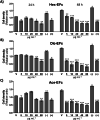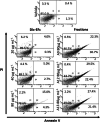Phytochemical profile and antiproliferative effect of Ficus crocata extracts on triple-negative breast cancer cells
- PMID: 32571387
- PMCID: PMC7309984
- DOI: 10.1186/s12906-020-02993-6
Phytochemical profile and antiproliferative effect of Ficus crocata extracts on triple-negative breast cancer cells
Abstract
Background: Some species of the Ficus genus show pharmacological activity, including antiproliferative activity, in cell lines of several cancer Types. ficus crocata is distributed in Mexico and used in traditional medicine, as it is believed to possess anti-inflammatory, analgesic, and antioxidant properties. However, as of yet, there are no scientific reports on its biological activity. This study aims to evaluate the phytochemical profile of F. crocata leaf extracts and their effects on breast cancer MDA-MB-231 cells proliferation. Moreover, the study aims to unearth possible mechanisms involved in the decrease of cell proliferation.
Methods: The extracts were obtained by the maceration of leaves with the solvents hexane, dichloromethane, and acetone. The phytochemical profile of the extracts was determined using gas chromatography coupled with mass analysis. Cell proliferation, apoptosis, and cell cycle analysis in MDA-MB-231 cells were determined using a Crystal violet assay, MTT assay, and Annexin-V/PI assay using flow cytometry. The data were analyzed using ANOVA and Dunnett's test.
Results: The hexane (Hex-EFc), dichloromethane (Dic-EFc), and acetone (Ace-EFc) extracts of F. crocata decreased the proliferation of MDA-MB-231 cells, with Dic-EFc having the strongest effect. Dic-EFc was fractioned and its antiproliferative activity was potentiated, which enhanced its ability to induce apoptosis in MDA-MB-231 cells, as well as increased p53, procaspase-8, and procaspase-3 expression.
Conclusions: This study provides information on the biological activity of F. crocata extracts and suggests their potential use against triple-negative breast cancer.
Keywords: Apoptosis; Breast cancer; Ficus crocata; MDA-MB-231 cells; Moraceae.
Conflict of interest statement
The authors declare that they have no competing interests.
Figures







References
-
- Badve S, Dabbs DJ, Schnitt SJ, Baehner FL, Decker T, Eusebi V, Fox SB, Ichihara S, Jacquemier J, Lakhani SR, Palacios J, Rakha EA, Richardson AL, Schmitt FC, Tan PH, Tse GM, Weigelt B, Ellis IO, Reis-Filho JS. Basal-like and triple-negative breast cancers: a critical review with an emphasis on the implications for pathologists and oncologists. Mod Pathol. 2011;24:157–167. doi: 10.1038/modpathol.2010.200. - DOI - PubMed
-
- Ramos AYD, Marmón TER, Crespo GC, Junco SB, Valiente MW. Breast cancer, its epidemiological characterization. Rev. Ciencias Médicas. 2015;19:619–629.
MeSH terms
Substances
Grants and funding
LinkOut - more resources
Full Text Sources
Research Materials
Miscellaneous

